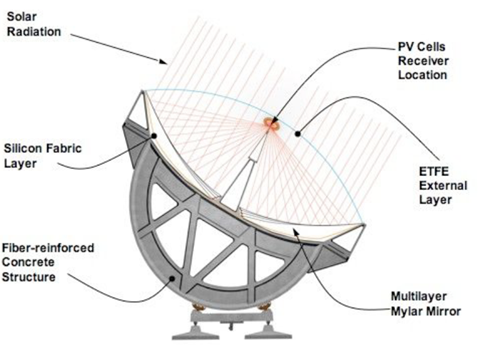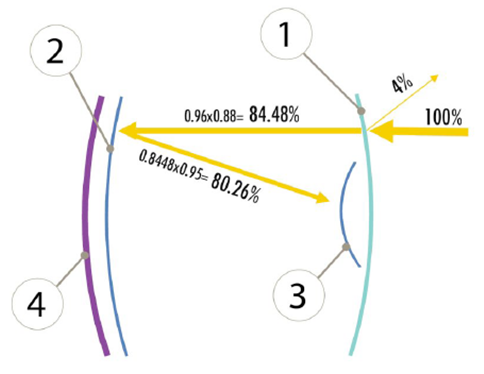KTI-Project InPhoCUS – Concentrated Photovoltaic Technology
Funding source: external page CTI-Innovation Promotion Agency
Partners: external page Airlight Energy, external page SUPSI-iCIMSI, external page SUPSI-ISAAC
Background – Among solar electricity generation technologies, photovoltaic (PV) technologies have seen the largest growth in interest over the last few years. The efficiency of this technology has well known limitations: for direct solar irradiation on flat PV panels, the efficiency of sun energy conversion to electric power is around 15%. A substantial improvement of this efficiency is obtained by the concentrating photovoltaic (CPV) technology. CPV systems make use of an optical apparatus to concentrate the solar radiation reaching the PV cells. Different types of optical concentrators include: Fresnel lenses, Fresnel mirrors, parabolic troughs, and parabolic dishes. The common aim of these systems is to have more electromagnetic energy hitting the PV surface thus affording a higher electric output from the same size PV panel. The benefit of so doing is twofold: 1) the economy of the system is improved by replacing expensive PV cells with less expensive optical elements; 2) the efficiency of the PV cell is augmented by higher incident solar fluxes resulting from the concentration. Using the same amount of land, CPV systems can produce more electricity, more efficiently and using much less PV material than conventional PV systems.
CPV systems are classified following their concentration intensity:
- low concentration: from 2 to 10 suns (1 sun = 1000 W/m2);
- medium concentration: from 10 to 100 suns;
- high concentration: greater than 100 suns.
Low concentration systems can use conventional silicon PV cells without cooling or tracking systems. Medium concentration systems require high-efficiency PV cells, cell cooling and sun tracking. High concentration systems require advanced multi-junction PV cells, complex optics and tracking systems, and active cooling and thermal damage prevention. At the current stage, medium concentration systems provide the best compromise between the economy of concentration and the simplicity and affordability of system components.
Recent studies have shown that the majority of cost for a CPV system is represented by the concentrator, its structure, and the tracking system mechanism. Therefore the greatest cost reductions can be achieved by targeting these technologies. The proposed CPV system features an innovative inflatable mirror system and rigid concrete structure and tracking system as shown in Fig. 1 and Fig. 2. The system relies on these two novel yet technologically simple innovations to achieve cost-competitiveness.


Goal – The goal of the InPhoCUS project is to realize a commercially cost-competitive innovative concentrating photovoltaic (CPV) system. The project will cover the design, construction and performance testing of the innovative system. The concentrator will be equipped with unconventional pneumatic multilayer Mylar mirrors, will have an innovative fiber-reinforced concrete structure and an original tilting mechanism to track the sun. The innovative CPV solar collector will be profitable for electric energy production plants both for the sun-belt region and in areas of lower insolation including southern European nations.
Objectives – The economy of the proposed CPV systems relies on four technologies:
- optics
- high-efficiency PV cells
- thermal management
- structure and sun-tracking
The objectives of the project are to design, optimize, construct and test the system focusing on the performance of the above four technologies. The role of ETH in the project will be focused on the optical design and testing of the mirrors and the modeling of the complete PV system. Specific tasks include:
- Development of a Monte Carlo ray-tracing model of the optical system.
- Optical design of the mirror and secondary optics to achieve optimal radiative flux uniformity optical efficiency.
- Setup of a radiative flux measurement system based on a Lambertian target and CCD camera with neutral filters.
- Measurement of the solar flux distribution at the focal plane.
- Validation of the ray-tracing model and final optimization.
- Incorporation of the ray-tracing model into a complete system model of the CPV system.
Project-related Publications